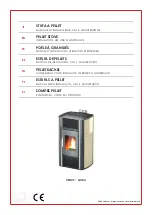
20
Astra P-10 USER MANUAL
• All stove components and ashes have cooled down sufficiently;
• Suitable tools will be used for cleaning;
• The electrical cable is unplugged when flue channels are to be
cleaned.
When cleaning the combustion chamber, be careful
and do not clog the pressure sensor’s pipe which is
mounted inside, on the left wall of the chamber, under a
vermiculite plate. The pipe must remain unobstructed.
The frequency of maintenance and cleaning depends directly on
the quality of pellets used. Burning high quality pellets allows you to
devote less time and attention to cleaning activities, and to increase
the periods between cleanings. Vice versa, bad quality pellets will
require shorter intervals between cleaning tasks. The quality of the
pellets and a sound adjustment of combustion are essential to the
reliable operation of the stove.
The pellet stove is a generator of heat and technically sophisticated
appliance. Therefore, we strongly recommend servicing by qualified
personnel at least once a year, at the start of the heating season to
ascertain and ensure the continued function and efficiency of all the
stove's components.
• EXTERIOR SURFACES CLEANING
To clean the surfaces on the painted metal parts, use a cloth slightly moistened in water. If necessary, mild soap may also be used.
Rub the surfaces gently and with care.
Do not use any aggressive detergents or solvents – they can cause serious damage to the surfaces of the
stove. Do not scrub excessively the metal paint - the structured paint surface changes its shading because
of rubbing impact.
• HEAT EXCHANGER TUBES CLEANING
The heat exchanger is composed of stainless steel tubes. Smoke flows constantly around the outer surface of the tubes leaving soot
residues on them. These residues must be removed every 2 days of operation. For this purpose, inside the heat exchanger there is a
scraper which brushes the tubes' surfaces like a comb. Pull the handle of the scraper 1 ( Fig. 12) towards yourself. To complete the
cleaning session, push and pull this handle till halting several times.
• ASHES DRAWER CLEANING
The ashes drawer must be cleaned daily or every 2-3 days,
depending on the length of time the stove is used and the quality
of pellets used. Open the door of the stove. Lift the handle of the
ashes drawer 4, pull out the drawer (Fig. 12) and empty ashes.
Be careful- surfaces can be hot! Clean the ashes
drawer only when the stove has cooled down!
• COMBUSTION CHAMBER CLEANING
Clean the combustion chamber every 2-3 days. Use a drum-type
vacuum cleaner for cleaning the combustion chamber. Make sure that no ashes are left after the cleaning session.
• FIRE POT CLEANING
A clean fire pot is of essential importance to assure uninterrupted stove operation. During the combustion process, increments of
ashes and slag fill up the holes of the pot (Fig. 14). These increments must be removed immediately because they block the air flow.
Fig. 13
Clean fire pot. No residue
inside, all the holes clean and
visible.
Fig. 14
Pot with the holes
blocked by ashes. Cleaning
required.
1
2
3
4
Fig. 12
Frequently inspected elements and their locations.
1. Scraper; 2. Combustion chamber; 3. Fire pot; 4. Ashes drawer.









































